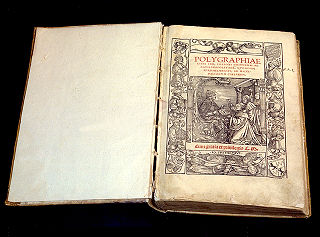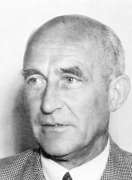
Cryptanalysis refers to the process of analyzing information systems in order to understand hidden aspects of the systems. Cryptanalysis is used to breach cryptographic security systems and gain access to the contents of encrypted messages, even if the cryptographic key is unknown.

In cryptography, the tabula recta is a square table of alphabets, each row of which is made by shifting the previous one to the left. The term was invented by the German author and monk Johannes Trithemius in 1508, and used in his Trithemius cipher.

William Frederick Friedman was a US Army cryptographer who ran the research division of the Army's Signal Intelligence Service (SIS) in the 1930s, and parts of its follow-on services into the 1950s. In 1940, subordinates of his led by Frank Rowlett broke Japan's PURPLE cipher, thus disclosing Japanese diplomatic secrets before America's entrance into World War II.

Étienne Bazeries was a French military cryptanalyst active between 1890 and the First World War. He is best known for developing the "Bazeries Cylinder", an improved version of Thomas Jefferson's cipher cylinder. It was later refined into the US Army M-94 cipher device. Historian David Kahn describes him as "the great pragmatist of cryptology. His theoretical contributions are negligible, but he was one of the greatest natural cryptanalysts the science has seen."

Books on cryptography have been published sporadically and with highly variable quality for a long time. This is despite the tempting, though superficial, paradox that secrecy is of the essence in sending confidential messages – see Kerckhoffs' principle.

Elizebeth Smith Friedman was an American cryptanalyst and author who deciphered enemy codes in both World Wars and helped to solve international smuggling cases during Prohibition. Over the course of her career, she worked for the United States Treasury, Coast Guard, Navy and Army, and the International Monetary Fund. She has been called "America's first female cryptanalyst".

Herbert Osborn Yardley was an American cryptologist. He founded and led the cryptographic organization the Black Chamber. Under Yardley, the cryptanalysts of The American Black Chamber broke Japanese diplomatic codes and were able to furnish American negotiators with significant information during the Washington Naval Conference of 1921–1922. Recipient of the Distinguished Service Medal. He wrote The American Black Chamber (1931) about his experiences there. He later helped the Nationalists in China (1938–1940) to break Japanese codes. Following his work in China, Yardley worked briefly for the Canadian government, helping it set up a cryptological section of the National Research Council of Canada from June to December 1941. Yardley was reportedly let go due to pressure either from the Secretary of War Henry L. Stimson or from the British.

The Codebreakers – The Story of Secret Writing (ISBN 0-684-83130-9) is a book by David Kahn, published in 1967, comprehensively chronicling the history of cryptography from ancient Egypt to the time of its writing. The United States government attempted to have the book altered before publication, and it succeeded in part.
Cryptography, the use of codes and ciphers to protect secrets, began thousands of years ago. Until recent decades, it has been the story of what might be called classical cryptography — that is, of methods of encryption that use pen and paper, or perhaps simple mechanical aids. In the early 20th century, the invention of complex mechanical and electromechanical machines, such as the Enigma rotor machine, provided more sophisticated and efficient means of encryption; and the subsequent introduction of electronics and computing has allowed elaborate schemes of still greater complexity, most of which are entirely unsuited to pen and paper.
Cryptologia is a journal in cryptography published six times per year since January 1977. Its remit is all aspects of cryptography, with a special emphasis on historical aspects of the subject. The founding editors were Brian J. Winkel, David Kahn, Louis Kruh, Cipher A. Deavours and Greg Mellen. The current Editor-in-Chief is Craig Bauer.

David Kahn was an American historian, journalist, and writer. He wrote extensively on the history of cryptography and military intelligence.

The National Cryptologic Museum (NCM) is an American museum of cryptologic history that is affiliated with the National Security Agency (NSA). The first public museum in the U.S. Intelligence Community, NCM is located in the former Colony Seven Motel, just two blocks from the NSA headquarters at Fort George G. Meade in Maryland. The motel was purchased, creating a buffer zone between the high security main buildings of the NSA and an adjacent highway. The museum opened to the public on December 16, 1993, and now hosts about 50,000 visitors annually from all over the world.
The Black Chamber, officially the Cable and Telegraph Section and also known as the Cipher Bureau, was the first peacetime cryptanalytic organization in the United States, operating from 1917 to 1929. It was a forerunner of the National Security Agency (NSA).
Below is a timeline of notable events related to cryptography.
Shihāb al-Dīn Abū 'l-Abbās Aḥmad ibn ‘Alī ibn Aḥmad ‘Abd Allāh al-Fazārī al-Shāfiʿī better known by the epithet al-Qalqashandī, was a medieval Egyptian encyclopedist, polymath and mathematician. A native of the Nile Delta, he became a Scribe of the Scroll, or clerk of the Mamluk chancery in Cairo, Egypt. His magnum opus is the voluminous administrative encyclopedia Ṣubḥ al-Aʿshá.
The cipher system that the Uesugi are said to have used is a simple substitution usually known as a Polybius square or "checkerboard." The i-ro-ha alphabet contains forty-eight letters, so a seven-by-seven square is used, with one of the cells left blank. The rows and columns are labeled with a number or a letter. In the table below, the numbers start in the top left, as does the i-ro-ha alphabet. In practice these could start in any corner.

Cryptography, or cryptology, is the practice and study of techniques for secure communication in the presence of adversarial behavior. More generally, cryptography is about constructing and analyzing protocols that prevent third parties or the public from reading private messages. Modern cryptography exists at the intersection of the disciplines of mathematics, computer science, information security, electrical engineering, digital signal processing, physics, and others. Core concepts related to information security are also central to cryptography. Practical applications of cryptography include electronic commerce, chip-based payment cards, digital currencies, computer passwords, and military communications.

In the history of cryptography, 91-shiki ōbun injiki or Angōki Taipu-A, codenamed Red by the United States, was a diplomatic cryptographic machine used by the Japanese Foreign Office before and during World War II. A relatively simple device, it was quickly broken by western cryptographers. The Red cipher was succeeded by the Type B "Purple" machine which used some of the same principles. Parallel usage of the two systems assisted in the breaking of the Purple system.

Madame Maria de Victorica, or Baroness Maria von Kretschamn, was the daughter of a Prussian cavalry officer, Baron Hans von Kretschman, and Countess Jenny von Gustedt, a diplomat. She was also the granddaughter of the illegitimate child of Jenny von Pappenheim and Jérome Bonaparte. She is known for her espionage activities during World War I. She also used the alias Marie de Vussière, and was said to dominate many European languages with fluency and had many university degrees.

Wilhelm Tranow was a German cryptanalyst, who before and during World War II worked in the monitoring service of the German Navy and was responsible for breaking a number of encrypted radio communication systems, particularly the Naval Cypher, which was used by the British Admiralty for encrypting operational signals and the Naval Code for encrypting administrative signals. Tranow was considered one of the most important cryptanalysts of B-service. He was described as being experienced and energetic. Little was known about his personal life, when and where he was born, or where he died.














